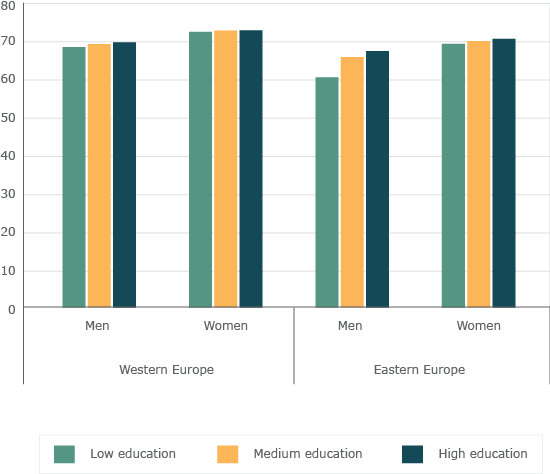Do different ageing patterns exist in different European areas, and is there a difference between East and West? To study the distinctive patterns of ageing by gender, and education in 16 European countries, Warren C. Sanderson and Sergei Scherbov use prospective ages in place of chronological ages. Prospective ages take changes in life expectancy into account. Prospective ages are based on how many years people have ahead of them, while chronological age is the number of years people have already lived. Sanderson and Scherbov confirm that one important feature influencing ageing is peoples’ education: overall, differences between men and women tend to diminish as education levels increase. Across Eastern and Western Europe, ageing differences tend to disappear as education increases.
The authors shed further light on the role played by education illustrating that the distinctive patterns of ageing of Eastern Europe depend on the rapid aging of less educated men. Thus, they suggest the likelihood that further improvements in educational levels would generate the convergence of Eastern ageing trajectories to those of Western Europe.
Their findings indicate that ageing patterns diverge between Eastern and Western European countries: when establishing the age at which people are referred to as older people, Eastern countries show the largest differences among educational groups.
Redefining the older population
People in all countries do not automatically are referred to as older people at age 65. For comparative purposes some old age threshold is necessary. Sanderson and Scherbov study differences in ageing using the prospective old age thresholds, defining it as the age at which remaining life expectancy falls below 15 years. The authors found that, on average, more highly educated men in Western Europe reach the prospective old age threshold at the age of 69 while those that have a lower level of education do just one year before, at 68 (Figure 1). Among women the difference is even smaller, only 0.39 years between those with high and low education.
In Eastern Europe the level of education plays a much more important role. There people reach the prospective old age threshold at a younger chronological age and differences among educational groups are larger. In these countries, men with high education reach the prospective old age threshold at the age of 67 and those with low education age at 60, seven years before than their counterparts in the first group. Both men and women in Eastern Europe enter old age before their Western European counterparts, but differences are larger among men.
Education and gender do matter
Sanderson and Scherbov also found that the patterns of ageing from age 40 onward are similar for men and women among the more educated. But gender does play an important role in ageing patterns for those with lower levels of education. This is so because, on average, men with low education become older people faster than women with low education. Such a difference might be partially due to poor health behaviours of those with less education, such as smoking and drinking.

Figure 1. Old age thresholds by level of education, males and females, 16 European Countries, (latest available year, 2007 to 2010).
Note: Old age thresholds are the chronological ages at which remaining life expectancy is equal to 15 years.
This Population Digest has been published with financial support from the Progress Programme of the European Union in the framework of the project “Supporting a Partnership for Enhancing Europe’s Capacity to Tackle Demographic and Societal Change”.